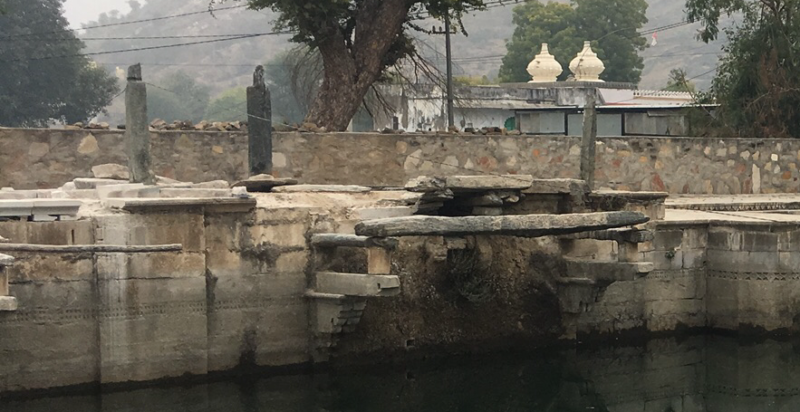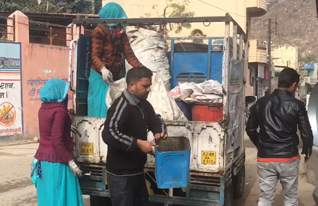Double the normal monsoon rainfall in 2019 has left a legacy of flowing streams, lakes aplenty and green pastures. Mountains are as ever brown but, in the valleys, an agricultural revolution.


Irrigated land has given new opportunities for what can be grown. Some fields, instead of being used to grow maize, can now be used to grow marigolds and roses to be sold at nearby temples (a very successful donor-funded project introduced by Seva Mandir). Flowers generate three or four times the yield of maize. More revenue for the village gives new development options, no longer just subsistence farming.
New types of wheat which do not grow so high are protected from the winds, giving more confidence in a successful harvest.
Mountains protected by walls, overseen by watchful protectors, produce grass to be shared between villagers. In the village I visited, no fewer than 200 families were benefiting from this community purpose. The recovery and protection of encroached common land has long been patiently encouraged by Seva Mandir.
Many villages have water tanks fed by wells, accessed by taps. So, women have much less distance to walk, take much less time to queue, and have much less need to waste energy on the old manual pump. I asked how the women were using the time regained and was surprised, and delighted, to hear their response of having time for rest and sometimes to sleep. How wonderful!
As profoundly, the village women gain confidence to manage village affairs, increasingly leading the way, be that infrastructure development or human rights.
I see solar energy panels supplying all the electricity for our residential school serving the most needy kids. Newly decorated classrooms, cooled by fans thanks to the solar power.



I see wood burners newly redesigned to improve air flow, eliminating black smoke, leading to a 60% reduction of emissions.
The youth programme funded by St James’s Place has excited teenagers to play soccer, girls and boys alike. This is no idle pastime, the kids wearing proper football boots and shin pads, learning how to play the game properly, their serious desire to take on new skills. Football is a way of breaking down barriers and also drawing youngsters into Seva Mandir’s village youth centres which offer skills training and teach the teenagers about sexual and reproductive health and gender equality.

I am thrilled to hear of a new partnership which allows the Seva Mandir health centre to be staffed by nurses with a doctor on call and in attendance for a day every week. In a little over a year the centre has already attended to 6,000 patients.
Smart phones are now pervasive in villages, allowing dispersed communities to connect and, importantly, data to be collected in real time on village projects. I am reminded of that old business adage: What gets measured gets done.
In Kelwara, the waste management pioneered some years ago in Delwara has led to the cleanest high street that I have seen in India. Twice a day the Seva Mandir-branded disposal tuk-tuk sails along the high street, two women loading the segregated dry and wet waste and accompanying it to the disposal site.


The wet waste is left to decompose for fertiliser, and the dry waste is further segregated into paper, plastic bottles, other plastic and polystyrene trays. Paper and plastic bottles are passed on for recycling. The other forms of plastic are passed on to cement makers who burn it at ferociously high temperature, eliminating toxic emissions. The polystyrene remains an enigma, the recycling answer yet to be identified.
I visited a village where every home had a toilet and a shower constructed with the help of the villagers. I asked rather indelicately how well the toilets were used and the assertive reply was ‘all the time’. One villager told us that when a visitor from another village did not use the facilities, he was fined 100 rupees.
In Delwara, the beautiful old step-well is being repaired so it once again can take its place as a centre of relaxation and fun.


In partnership with donor Hindustan Zinc, Seva Mandir has now strengthened over 1,300 government-run nurseries. Wonderful to see so many villages benefiting from Seva Mandir’s expertise.
I saw villages where Seva Mandir’s impact over a generation could not be clearer: schools, wells, loos, women’s groups; and now no real day-to-day need for Seva Mandir’s presence. This is true sustainability and there is no truer statement than:
You can take Seva Mandir funding away from the village
but
you cannot take the village away from Seva Mandir values
Chris Wiscarson, February, 2020

